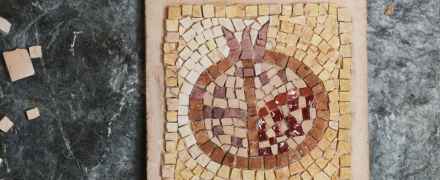open 10 am - 7 pm
laboratory is closed
History of stone mosaics (part 1)

The next few publications we would like to devote to mosaics, their history, varieties and characteristics. One of the very first types of ancient stone mosaics that have come down to us are polygonal masonry in the ancient "cities of the gods", spread throughout the world - in Egypt, India, China, Peru. The surfaces of the joints of stones in such masonry were additionally worked for a snug fit. The outer surfaces of the blocks, as a rule, had a decorative treatment. The oldest known such structures date back to the period before 500 BC. The very first decorative ornamental stone tiles, dating back to the first centuries BC, are known from the temples of Egypt, the Middle East, Asia Minor and the Greco-Mediterranean civilization region. But the real flourishing of decorative masonry and mosaic design in the construction of residential and religious premises, where the shape and color of the stone was used to create patterns, fell on the first centuries of our era. The most widely used stone mosaics are found in ancient monuments of the Roman era. The material of the mosaics is very diverse - from whole pebbles and individual color and textured blocks to plates cut along the contour, corresponding in color and texture to the meaning of the composition. Typically, relatively soft materials from the surrounding areas were used to make such floor and wall mosaics. Mosaics of various stones, cut in shape in accordance with the concept of the composition, are united by one term - "opus sectile" - literally translated from Latin "sectional work", or in modern language - block or "piece" mosaic.
В геммологической практике бывают весьма увлекательные случаи с диагностикой ювелирных вставок
Но помимо редкости цвета и высокой стоимости таких камней, многие розовые камни выделяются одной замечательной особенностью – они проявляют плеохроизм, то есть в зависимости от положения осмотра камня он может иметь дополнительные оттенки – оранжевый или пурпурный.
Currently, gemstones are produced by two fundamentally different technological methods - the High Pressure - High Temperature method (“HPHT”, High-pressure & High-temperature) and the Chemical Vapor Deposition (“CVD”, Chemical vapor deposition) method. The "HPHT" method is the most tested classical synthesis method, which can be used both carbon deposition on diamond from flux melts and catalytic reactions. In "CVD" synthesis, diamond growth occurs on a seed during carbon deposition mainly from a gaseous medium at relatively low temperatures and pressures.
Jewelry and precious stones are just such a category of goods, when buying which you need to pay attention to many criteria.
Sogdianite is a rather rare mineral and more often it can be found as a collection material (moreover, in systematic collections), and it is extremely rare in jewelry.






